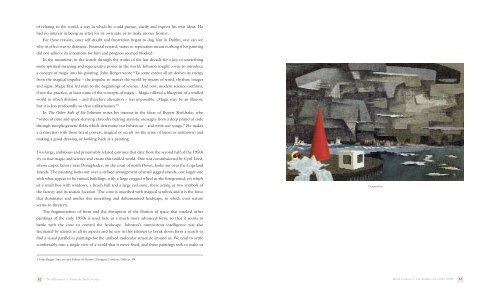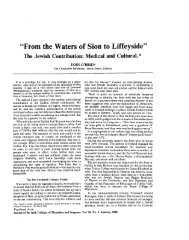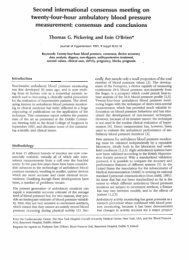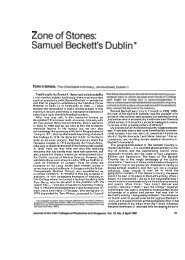Nevill Johnson: Paint the smell of grass - Eoin O'Brien
Nevill Johnson: Paint the smell of grass - Eoin O'Brien
Nevill Johnson: Paint the smell of grass - Eoin O'Brien
You also want an ePaper? Increase the reach of your titles
YUMPU automatically turns print PDFs into web optimized ePapers that Google loves.
<strong>of</strong> relating to <strong>the</strong> world, a way in which he could pursue, clarify and express his own ideas. He<br />
had no interest in being an artist for its own sake or to make money from it.<br />
For <strong>the</strong>se reasons, once self-doubt and frustration began to dog him in Dublin, one can see<br />
why its effect was so dramatic. Financial reward, status or reputation meant nothing if his painting<br />
did not achieve its intentions for him and progress seemed blocked.<br />
In <strong>the</strong> meantime, in <strong>the</strong> search through <strong>the</strong> works <strong>of</strong> <strong>the</strong> last decade for a key to unearthing<br />
some spiritual meaning and regenerative power in <strong>the</strong> world, <strong>Johnson</strong> sought a way to introduce<br />
a concept <strong>of</strong> magic into his painting. John Berger wrote “To some extent all art derives its energy<br />
from <strong>the</strong> magical impulse – <strong>the</strong> impulse to master <strong>the</strong> world by means <strong>of</strong> word, rhythm, images<br />
and signs. Magic first led man to <strong>the</strong> beginnings <strong>of</strong> science. And now, modern science confirms,<br />
if not <strong>the</strong> practice, at least some <strong>of</strong> <strong>the</strong> concepts <strong>of</strong> magic…Magic <strong>of</strong>fered a blueprint <strong>of</strong> a unified<br />
world in which division – and <strong>the</strong>refore alienation – was impossible…Magic may be an illusion,<br />
but it is less pr<strong>of</strong>oundly so than utilitarianism.” 3<br />
In The O<strong>the</strong>r Side <strong>of</strong> Six <strong>Johnson</strong> notes his interest in <strong>the</strong> ideas <strong>of</strong> Rupert Sheldrake, who<br />
“writes <strong>of</strong> time and space-denying chreodes bearing atavistic messages from a deep primeval code<br />
through morphogenetic fields which determine our behaviour – and write our songs.” He makes<br />
a connection with <strong>the</strong>se latent powers, magical or occult (in <strong>the</strong> sense <strong>of</strong> latent or unknown) and<br />
making a good drawing or looking back at a painting.<br />
Two large, ambitious and presumably related canvases that date from <strong>the</strong> second half <strong>of</strong> <strong>the</strong> 1950s<br />
try to fuse magic and science and create this unified world. One was commissioned by Cyril Lord,<br />
whose carpet factory near Donaghadee, on <strong>the</strong> coast <strong>of</strong> north Down, looks out over <strong>the</strong> Copeland<br />
Islands. The painting looks out over a stylised arrangement <strong>of</strong> small jagged islands, one larger one<br />
with what appear to be ruined buildings, with a large cogged wheel in <strong>the</strong> foreground, on which<br />
sit a small box with windows, a beach ball and a large red cone, <strong>the</strong>se acting as two symbols <strong>of</strong><br />
<strong>the</strong> factory and its seaside location. The cone is inscribed with magical symbols and it is <strong>the</strong> force<br />
that dominates and unifies this unsettling and dehumanised landscape, in which even nature<br />
seems to threaten.<br />
The fragmentation <strong>of</strong> form and <strong>the</strong> disruption <strong>of</strong> <strong>the</strong> illusion <strong>of</strong> space that marked o<strong>the</strong>r<br />
paintings <strong>of</strong> <strong>the</strong> early 1950s is used here in a much more advanced form, so that it seems to<br />
battle with <strong>the</strong> cone to control <strong>the</strong> landscape. <strong>Johnson</strong>’s omnivorous intelligence was also<br />
fascinated by science in all its aspects and he saw in this attempt to break down form a search to<br />
find a visual parallel in paintings for <strong>the</strong> unfixed molecular structure around us. We tend to settle<br />
comfortably into a single view <strong>of</strong> a world that is never fixed, and <strong>the</strong>se paintings seek to make us<br />
3 John Berger ‘Success and Failure <strong>of</strong> Picasso’, Penguin, London, 1965, p. 99<br />
52 <strong>Nevill</strong> <strong>Johnson</strong> l <strong>Paint</strong> <strong>the</strong> Smell <strong>of</strong> Grass<br />
Composition<br />
<strong>Nevill</strong> <strong>Johnson</strong> l The Dublin years 1947–1958 53









